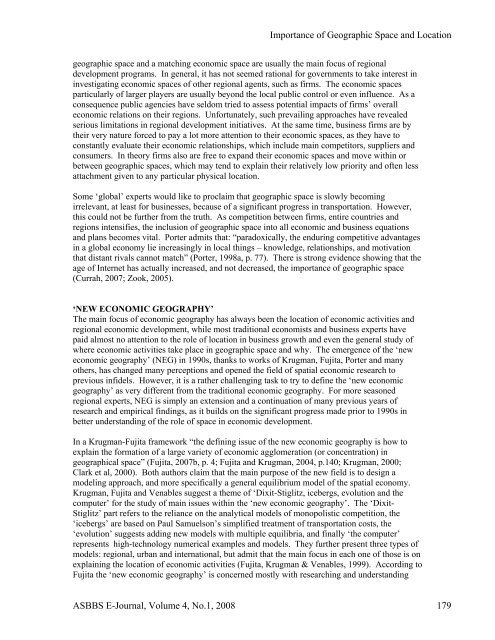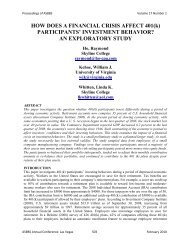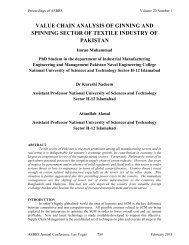stock repurchase announcements: a test of market ... - Asbbs.org
stock repurchase announcements: a test of market ... - Asbbs.org
stock repurchase announcements: a test of market ... - Asbbs.org
You also want an ePaper? Increase the reach of your titles
YUMPU automatically turns print PDFs into web optimized ePapers that Google loves.
Importance <strong>of</strong> Geographic Space and Location<br />
geographic space and a matching economic space are usually the main focus <strong>of</strong> regional<br />
development programs. In general, it has not seemed rational for governments to take interest in<br />
investigating economic spaces <strong>of</strong> other regional agents, such as firms. The economic spaces<br />
particularly <strong>of</strong> larger players are usually beyond the local public control or even influence. As a<br />
consequence public agencies have seldom tried to assess potential impacts <strong>of</strong> firms’ overall<br />
economic relations on their regions. Unfortunately, such prevailing approaches have revealed<br />
serious limitations in regional development initiatives. At the same time, business firms are by<br />
their very nature forced to pay a lot more attention to their economic spaces, as they have to<br />
constantly evaluate their economic relationships, which include main competitors, suppliers and<br />
consumers. In theory firms also are free to expand their economic spaces and move within or<br />
between geographic spaces, which may tend to explain their relatively low priority and <strong>of</strong>ten less<br />
attachment given to any particular physical location.<br />
Some ‘global’ experts would like to proclaim that geographic space is slowly becoming<br />
irrelevant, at least for businesses, because <strong>of</strong> a significant progress in transportation. However,<br />
this could not be further from the truth. As competition between firms, entire countries and<br />
regions intensifies, the inclusion <strong>of</strong> geographic space into all economic and business equations<br />
and plans becomes vital. Porter admits that: “paradoxically, the enduring competitive advantages<br />
in a global economy lie increasingly in local things – knowledge, relationships, and motivation<br />
that distant rivals cannot match” (Porter, 1998a, p. 77). There is strong evidence showing that the<br />
age <strong>of</strong> Internet has actually increased, and not decreased, the importance <strong>of</strong> geographic space<br />
(Currah, 2007; Zook, 2005).<br />
‘NEW ECONOMIC GEOGRAPHY’<br />
The main focus <strong>of</strong> economic geography has always been the location <strong>of</strong> economic activities and<br />
regional economic development, while most traditional economists and business experts have<br />
paid almost no attention to the role <strong>of</strong> location in business growth and even the general study <strong>of</strong><br />
where economic activities take place in geographic space and why. The emergence <strong>of</strong> the ‘new<br />
economic geography’ (NEG) in 1990s, thanks to works <strong>of</strong> Krugman, Fujita, Porter and many<br />
others, has changed many perceptions and opened the field <strong>of</strong> spatial economic research to<br />
previous infidels. However, it is a rather challenging task to try to define the ‘new economic<br />
geography’ as very different from the traditional economic geography. For more seasoned<br />
regional experts, NEG is simply an extension and a continuation <strong>of</strong> many previous years <strong>of</strong><br />
research and empirical findings, as it builds on the significant progress made prior to 1990s in<br />
better understanding <strong>of</strong> the role <strong>of</strong> space in economic development.<br />
In a Krugman-Fujita framework “the defining issue <strong>of</strong> the new economic geography is how to<br />
explain the formation <strong>of</strong> a large variety <strong>of</strong> economic agglomeration (or concentration) in<br />
geographical space” (Fujita, 2007b, p. 4; Fujita and Krugman, 2004, p.140; Krugman, 2000;<br />
Clark et al, 2000). Both authors claim that the main purpose <strong>of</strong> the new field is to design a<br />
modeling approach, and more specifically a general equilibrium model <strong>of</strong> the spatial economy.<br />
Krugman, Fujita and Venables suggest a theme <strong>of</strong> ‘Dixit-Stiglitz, icebergs, evolution and the<br />
computer’ for the study <strong>of</strong> main issues within the ‘new economic geography’. The ‘Dixit-<br />
Stiglitz’ part refers to the reliance on the analytical models <strong>of</strong> monopolistic competition, the<br />
‘icebergs’ are based on Paul Samuelson’s simplified treatment <strong>of</strong> transportation costs, the<br />
‘evolution’ suggests adding new models with multiple equilibria, and finally ‘the computer’<br />
represents high-technology numerical examples and models. They further present three types <strong>of</strong><br />
models: regional, urban and international, but admit that the main focus in each one <strong>of</strong> those is on<br />
explaining the location <strong>of</strong> economic activities (Fujita, Krugman & Venables, 1999). According to<br />
Fujita the ‘new economic geography’ is concerned mostly with researching and understanding<br />
ASBBS E-Journal, Volume 4, No.1, 2008 179

















